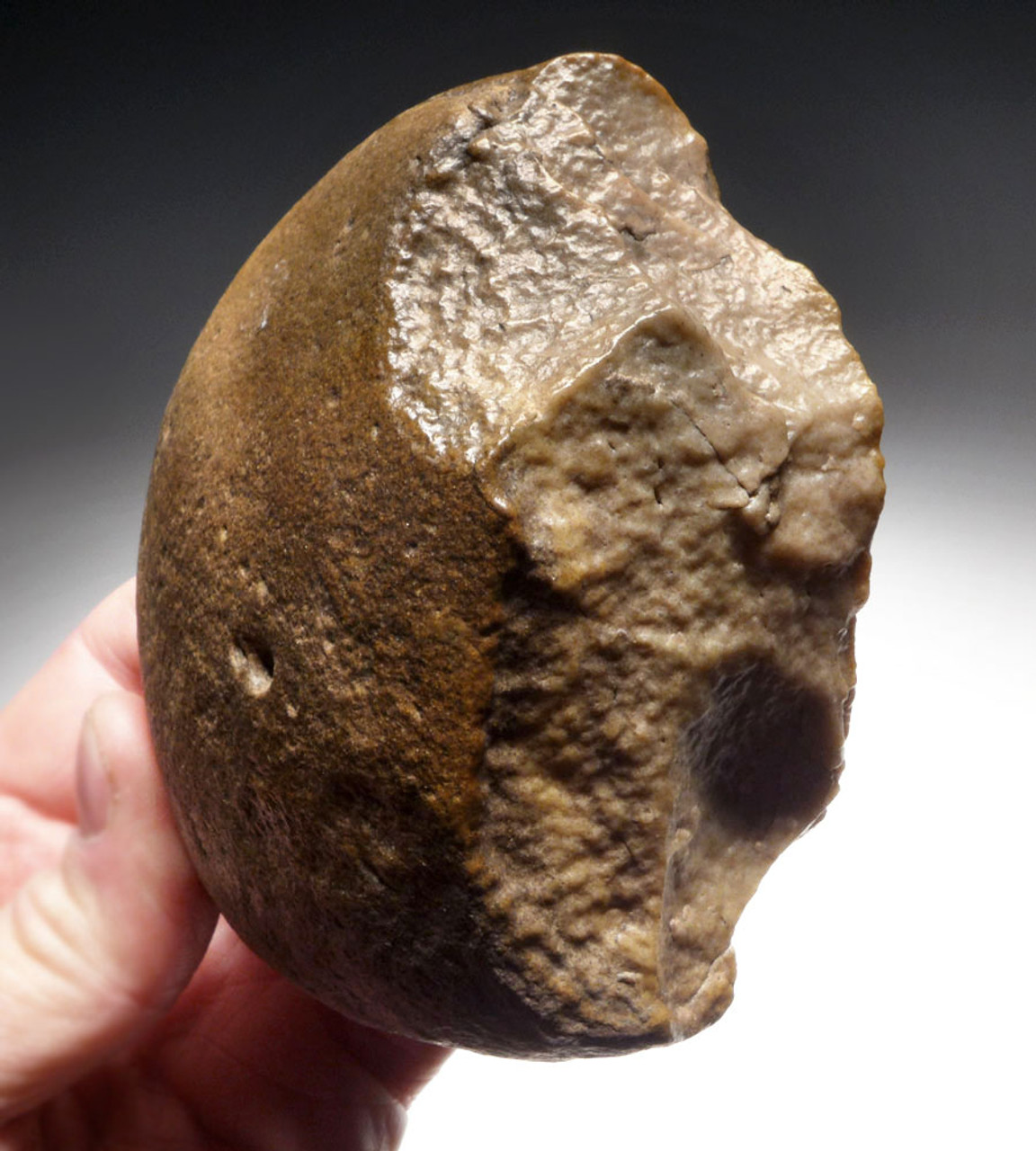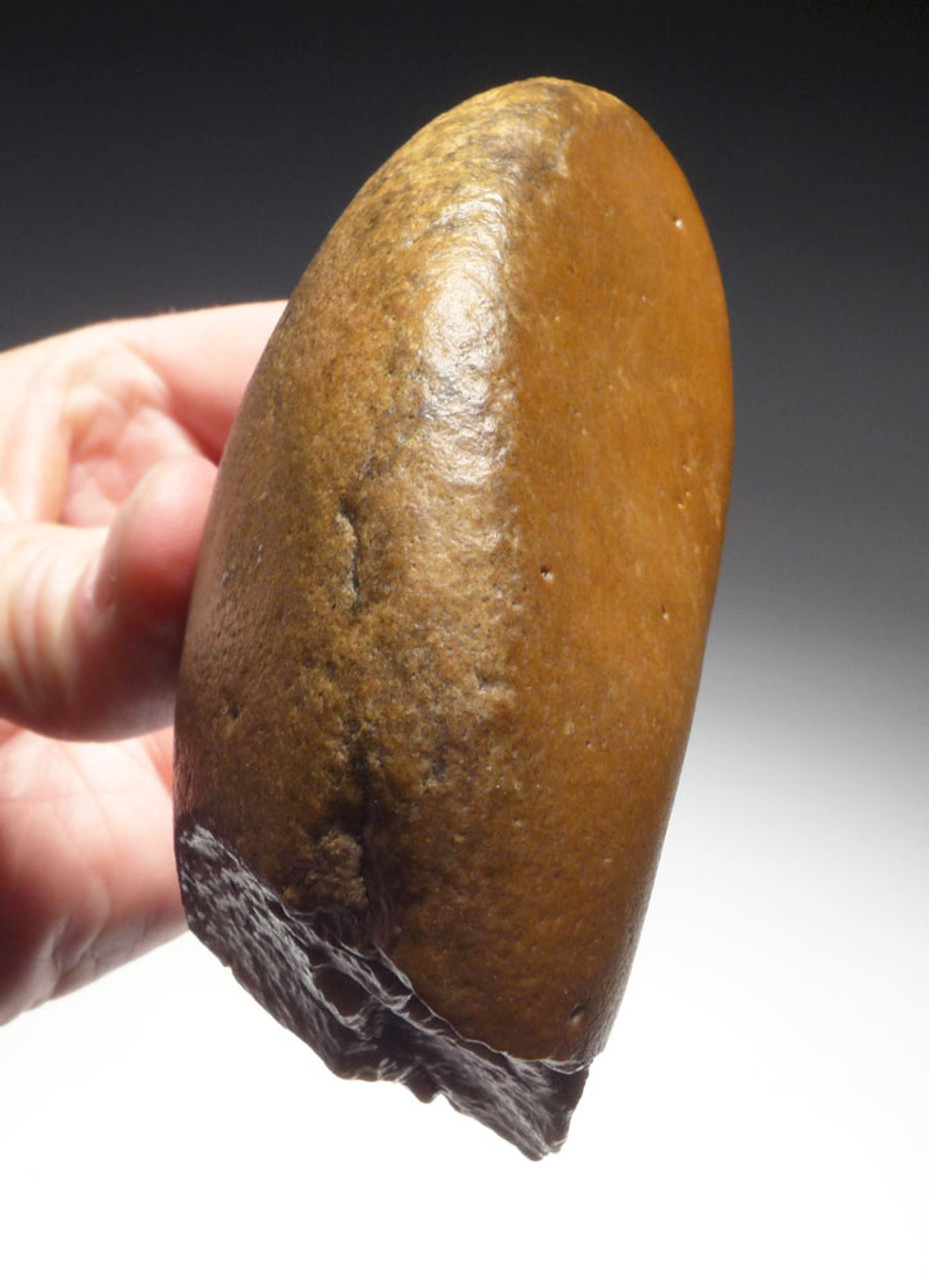Product Description
This is a classic MODE 1 OLDOWAN PEBBLE CHOPPER AXE and is a perfect candidate for demonstrating the earliest primary human stone tool of the Oldowan Tradition of Africa's Lower Paleolithic Period. Pebble tools made in the Mode 1 Oldowan technology are the oldest human artifacts in existence.
This museum-class specimen is made from basalt with an exceptional "desert varnish" patina. A natural bend in the original cobble was ingeniously utilized as an ergonomic grip. The chopping edge is complete and undamaged with no modern handling damage. It shows a blunt chisel end made by several oblique strikes - features ONLY seen in human-made tools versus stones broken in nature.
A pebble chopper axe like this would have been ideal to smash open the bones of large hunted game to access nourishing bone marrow, a rich and nutritious food source in prehistory. Workmanship, form and overall preservation of this pebble chopper axe is TRULY MUSEUM QUALITY.
The minute crevices of the surface of the stone show no modern crushing or flaking and are filled with desert sediment testifying to its authenticity. The entire pebble axe shows a wonderful "desert varnish" patina - a thin, dark red to black mineral coating (generally iron and manganese oxides and silica) deposited on pebbles and rocks on the surface of desert regions. Studies indicate that the varnish materials generally are extracted from the surrounding rock and earth material. Wind abrasion removes the softer salts and polishes the patina to a glossy finish.
African pebble tools are not common on the market compared to their much later Acheulian relatives. This specimen is part of a very limited collection we acquired. African pebble tools were never commercially collected and rarely available for public acquisition. This offering poses a rare opportunity to own an AUTHENTIC example of the first known tool type made by humans - a window into the mind and design thought process of our earliest ancestors.
No one can doubt the importance that pebble tools hold in the history of human development. Their very emergence in Africa nearly two million years ago allowed the earliest humans to butcher animals for their meat - the needed nourishment that allowed humans to survive and flourish to one day populate and rule the earth.
HISTORY
Oldowan pebble tools are THE FIRST recognized tools invented by the earliest of primitive humans from Africa. The Oldowan (or Mode I) was a widespread stone tool archaeological industry (style) in prehistory. These early tools were simple, usually made with one or a few flakes chipped off with another stone. Oldowan tools were used during the Lower Paleolithic period, 2.6 million years ago up until at least 1.7 million years ago, by ancient Hominins (early humans) across much of Africa. This technological industry was followed by the more sophisticated Acheulean industry. Oldowan stone tools are simply the oldest recognizable tools which have been preserved in the archaeological record. Early species of Homo such as H. habilis and H. ergaster are believed to be the primary tool makers of the industry during much of its use. Early Homo erectus appears to inherit Oldowan technology and refines it into the Acheulean industry beginning 1.7 million years ago.
The term Oldowan is taken from the site of Olduvai Gorge in Tanzania, where the first Oldowan stone tools were discovered by the archaeologist Louis Leakey in the 1930s. Some contemporary archaeologists and palaeoanthropologists prefer to use the term Mode 1 tools to designate pebble tool industries (including Oldowan), with Mode 2 designating bifacially worked tools (including Acheulean handaxes), Mode 3 designating prepared-core tools, and so forth.
There is a flourishing of Oldowan tools in eastern Africa, spreading to southern Africa, between 2.4 and 1.7 mya. At 1.7 mya., the first Acheulean tools appear even as Oldowan assemblages continue to be produced. Both technologies are occasionally found in the same areas, dating to the same time periods. This realization required a rethinking of old cultural sequences in which the more "advanced" Acheulean was supposed to have succeeded the Oldowan. The different traditions may have been used by different species of hominins living in the same area, or multiple techniques may have been used by an individual species in response to different circumstances.
By 1.8 mya early Homo was present in Europe, as shown by the discovery of fossil remains and Oldowan tools in Dmanisi, Georgia. Remains of their activities have also been excavated in Spain at sites in the Guadix-Baza basin and near Atapuerca. Most early European sites yield "Mode 1" or Oldowan assemblages. The earliest Acheulean sites in Europe only appear around 0.5 mya. In addition, the Acheulean tradition does not seem to spread to Eastern Asia. It is unclear from the archaeological record when the production of Oldowan technologies ended. Other tool-making traditions seem to have supplanted Oldowan technologies by 0.25 mya.
No one can doubt the importance that pebble tools hold in the history of human development. Their very emergence in Africa allowed the earliest humans to butcher animals for their meat - the needed nourishment that allowed humans to survive and flourish to one day populate and rule the earth.
.
 US DOLLAR
US DOLLAR
 EURO
EURO
 AUSTRALIAN DOLLAR
AUSTRALIAN DOLLAR
 CANADIAN DOLLAR
CANADIAN DOLLAR
 POUND STERLING
POUND STERLING
























